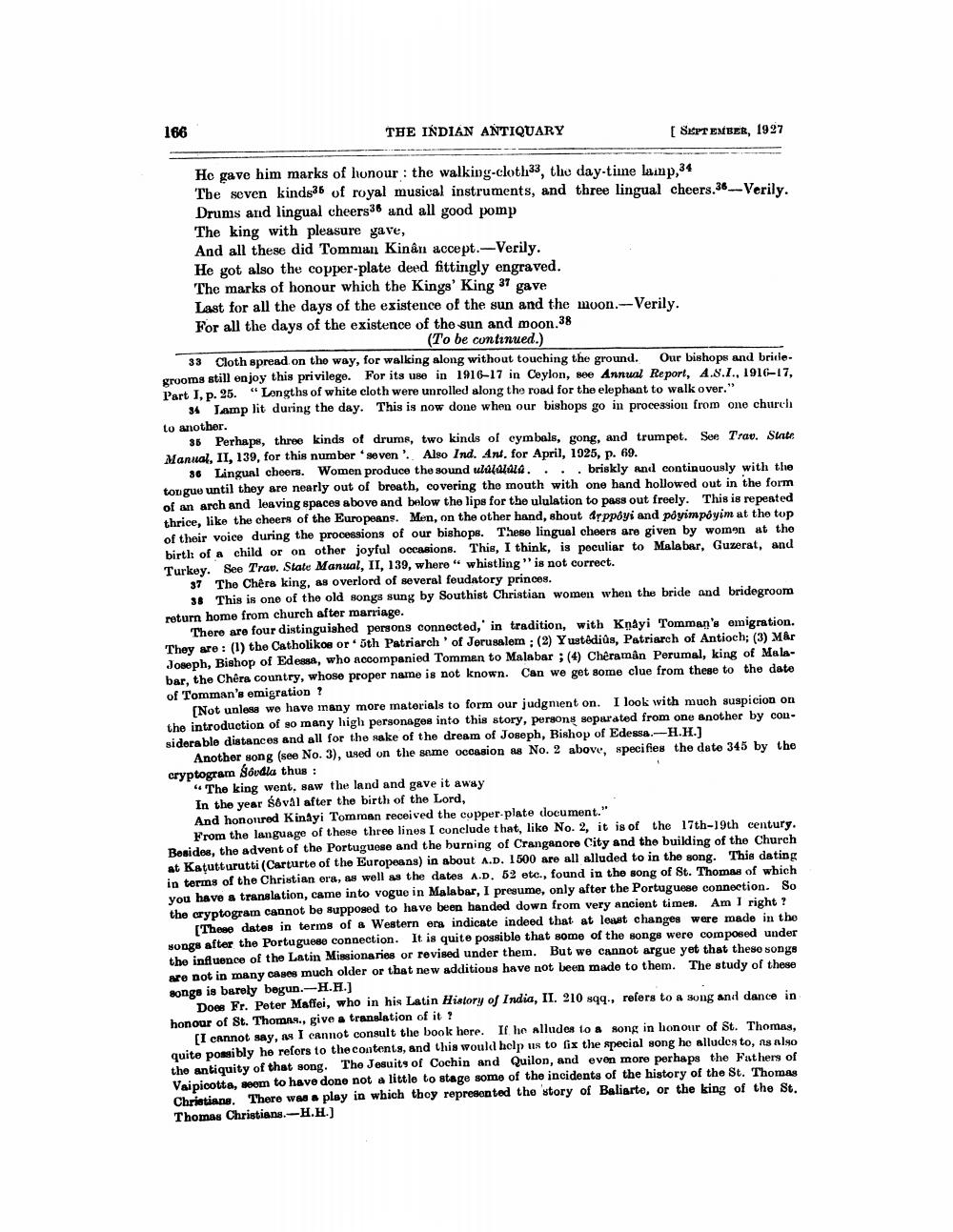________________
166
THE INDIAN ANTIQUARY
[ SEPTEMBER, 1927
He gave him marks of honour : the walking-cloth33, the day-tiine lamp,34 The seven kinds36 of royal musical instruments, and three lingual cheers, 36--Verily. Drums and lingual cheers36 and all good pomp The king with pleasure gave, And all these did Tomman Kinan accept.-Verily. He got also the copper-plate deed fittingly engraved. The marks of honour which the Kings' King ® gave Last for all the days of the existence of the sun and the moon.--Verily. For all the days of the existence of the sun and moon.38
(To be continued.) 33 Cloth spread on the way, for walking along without touching the ground. Our bishops and bride. grooms still enjoy this privilege. For its use in 1916–17 in Ceylon, see Annual Report, 4.8.1., 1916-17, Part I, p. 25. "Longths of white cloth were unrolled along the road for the elephant to walk over."
34 Lamp lit during the day. This is now done when our bishops go in procession from one church to another.
36 Perhaps, three kinds of drums, two kinds of cymbals, gong, and trumpet. See Trav. Sinte Manual, II, 139, for this number seven'. Also Ind. An for April, 1925, p. 69.
36 Lingual cheers. Women produce the sound ululaida... briskly and continuously with the tongue until they are nearly out of breath, covering the mouth with one hand hollowed out in the form of an arch and leaving spaces above and below the lips for the ululation to pass out freely. This is repeated thrice, like the cheers of the Europeans. Men, on the other hand, shout drppoyi and pôyimpôyim at the top of their voice during the processions of our bishops. These lingual cheers are given by women at the birth of a child or on other joyful occasions. This, I think, is peculiar to Malabar, Guzerat, and Turkey. See Trav. State Manual, II, 139, where " whistling is not correct.
37 The Chêra king, as overlord of several feudatory princes.
38 This is one of the old songs sung by Southist Christian women when the bride and bridegroom return home from church after marriage.
There are four distinguished persons connected,' in tradition, with Knayi Tomman's emigration. They are: (1) the Catholikoe or 5th Patriarch of Jerusalem : (2) Yustódius, Patriarch of Antioch; (3) Mar Joseph, Bishop of Edeas, who accompanied Tommen to Malabar ;(4) Chéraman Perumal, king of Malabar, the Chêra country, whose proper name is not known. Can we get some clue from these to the date of Tomman's emigration ?
(Not unless we have many more materials to form our judgment on. I look with much suspicion on the introduction of so many high personages into this story, persons separated from one another by considerable distances and all for the sake of the dream of Joseph, Bishop of Edessa.-H.H.)
Another song (see No. 3), used on the some occasion as No. 2 above, specifies the date 345 by the cryptogram Soudla thus :
“The king went, saw the land and gave it away In the year sóval after the birth of the Lord, And honoured Kinayi Tomman received the copper plate document."
From the language of these three lines I conclude that, like No. 2, it is of the 17th-19th century. Besides, the advent of the Portuguese and the burning of Cranganore City and the building of the Church at Katutturutti (Carturte of the Europeans) in about A.D. 1500 are all alluded to in the song. This dating in terms of the Christian ora, as well as the dates A.D. 59 etc., found in the song of St. Thomas of which you have a translation, came into vogue in Malabar, I presume, only after the Portuguese connection. So the cryptogram cannot be supposed to have been handed down from very ancient times. Am I right?
These dates in terms of a Western era indicate indeed that at least changes were made in the songs after the Portuguese connection. It is quite possible that some of the songs were composed under the influence of the Latin Missionaries or revised under them. But we cannot argue yet that these songs Ne not in many cases much older or that new additious have not been made to them. The study of these songs is barely begun.-H.H.]
Does Fr. Peter Maffei, who in his Latin History of India, II. 910 599., refers to a song and dance in honour of St. Thomas, give a translation of it?
(I cannot say, 24 I cannot consult the book here. If he alludes lo & song in honour of St. Thomas, quite possibly he refers to the contents, and this would help us to fix the special song he alludes to, ns also the antiquity of that song. The Jesuits of Cochin and Quilon, and even more perhaps the Fathers of Vaipicotta, seem to have done not a little to stage some of the incidents of the history of the St. Thomas Christiana. There was a play in which thoy represented the story of Baliarte, or the king of the St. Thomas Christians.-H.H.)




